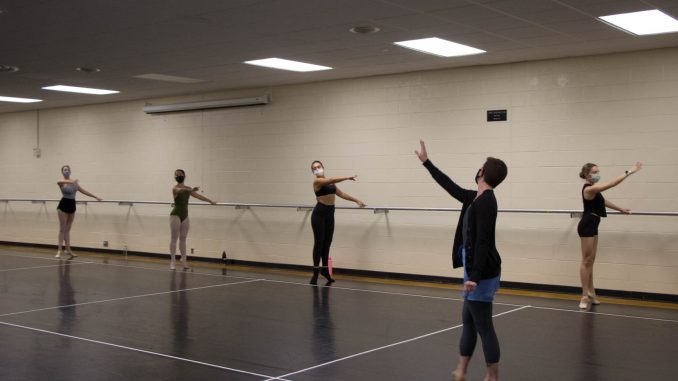
Teaching dance this semester is a tranquil experience for Merian Soto, since her corporeal improvisation class is held in Wissahickon Valley Park.
“Luckily I have a 15-year creative practice of dancing in the woods, which I can share with students,” said Soto, a dance professor at Boyer. “This work is both calming and energizing. Working with branches is a kind of social distancing insurance.”
Temple University courses deemed essential to operate in-person this semester range between mostly performance, ensemble and laboratory classes that involve more hands-on based skills. Faculty teaching the courses are adapting to COVID-19 precautions by taking class outdoors, installing plexiglass barriers in classrooms and moving students into smaller groups, while students in the courses are grateful for the class adaptations, despite their limitations.
On Sept 3, Temple University moved all nonessential classes online in response to rising COVID-19 cases on campus, The Temple News reported.
Classes “for which educational objectives cannot be achieved without all or some in-person instruction” would remain in-person while all others would move online, according to the university’s announcement.
The university deemed some performance, ensemble and laboratory classes in the Boyer College of Music and Dance, College of Science and Technology, and the School of Theater, Film and Media Arts essential and gave the schools the option for them to remain in-person.
As of Oct. 12, around 4,500 students are still taking in-person classes on Temple’s domestic campuses, wrote Ray Betzner, a spokesperson for the university, in an email to The Temple News.
There were 54 active COVID-19 cases among students and employees on campus reported on Oct. 12, The Temple News reported.
Deans of all schools and colleges worked with each other to decide what classes would be deemed essential and non-essential, wrote Donna Lamborne, the university’s vice provost of academic affairs, in an email to The Temple News.
They then informed faculty of whether their classes would remain in-person or not, Lamborne wrote.
Laura Katz Rizzo teaches Ballet I and Ballet Technique IV in-person Monday through Thursday. Teaching her course in-person is important since dancers’ preferred way of communicating with one another is through live interaction, Rizzo said.
“The students and I who are still able to meet in person feel very lucky for that opportunity,” Rizzo said. “For most of us, nothing can ever take the place of the shared experience of dancing together.”
Rizzo understood why Temple moved most classes online but thought it was important to have some classes in person if possible, she said.
“In order to master certain proficiencies, some practice-based classes or classes that require special facilities or equipment should continue to meet in person,” Rizzo said.
Rizzo gave her students the option to take her course online if they are not comfortable taking it in person, she said. She is teaching six students online and 10 in-person.
Soto’s graduate course operates under a hybrid model, meeting one day online and one day in person at Wissahickon Valley Park. She enjoys the in-person part of her class because it is difficult to keep students engaged and connected online, she said.
“I love meeting my students in the park, it’s a welcome break from online dance classes, which offer many challenges, and from the isolation of the pandemic,” Soto said.
Katherine Sullivan, a first year masters student in dance, takes Soto’s class and is happy to be in person despite some challenges, she said.
“With dance improvisation, I would say our biggest hurdle is not being able to work together in close proximity as a group, no partnering, no touching,” Sullivan said. “As dancers, we are very adaptable, so we are making do. However, it can feel frustrating to be limited in this way.”
Moriah Ella Mason, a first year masters student, is in Soto’s class and also teaches the undergraduate course Dance Composition I, which meets in person.
“It’s nice to be outdoors, we’re masked and we’re staying distanced but it’s a really nice relief to have one class with my [master of fine arts] cohort where we are getting to actually dance in person,” Mason said.
They are grateful for all the students’ flexibility and focus they have shown during this time in the course they are teaching, Mason said.
”It’s a really tricky time to be a student,” they added. “It’s a really tricky time to stay focused and I feel like overall my class really respects the work we’re doing.”
Tracy Nguyen, a first year masters student in bassoon performance, is taking Symphony Orchestra and Wind Symphony in person this semester.
Her in person classes have shortened rehearsals, implemented plexiglass barriers between musicians and placed absorbent pads on floors to prevent the circulation of air droplets exhaled from brass instruments, Nguyen said.
“I think that it just helps alleviate some of our uncertainties just rehearsing in person, but I think overall it’s been pretty positive and accommodating for the people who do rehearse in person,” Nguyen added.



Be the first to comment